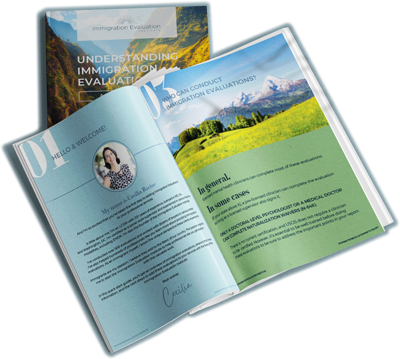What do you want to learn more about?
How to conduct telehealth immigration evaluations online during COVID-19

We are all adjusting to our new normal during the COVID-19 pandemic. For many of us who conduct immigration evaluations, this means learning to do them via telehealth. This can be especially tricky because clients don’t know us beforehand and they may face barriers accessing technology or finding a private place to speak.
Meanwhile, we are working out of our basements, closets, and bedrooms. We worry about our lighting, webcam, that we won’t be able to connect with our clients as well, etc.
I have one piece of advice: lower your standards.
Now, of course, I don’t mean you should lower your standards with regard to documentation, ethics, and confidentiality. Those are must-haves, but you can give yourself permission to relax about the other stuff. Why?
First of all, your clients have never done this either.
None of us know what we’re doing when it comes to living and working during a pandemic. We’re all learning as we go and doing the best we can, which means that our clients will be understanding when we screw up the video feed or appear upside down on their screen.
Secondly, they don’t know any different.
Unlike ongoing therapy, for an immigration evaluation, you only meet with a client a few times – which means they don’t have any previous experience with you. They won’t compare how different telehealth is to seeing you in the office.
Lastly, and possibly most importantly, lower your expectations because the last thing we need right now is more stress; we already have plenty to worry about.
This week, my phone ran out of battery mid eval, I dropped water on my lap while explaining consents, and accidentally flipped the camera so my client had a clear view of my bed – thankfully, it was made!
Were my evaluations perfect? Not even close.
Did my clients have the same experience as if they were sitting in my office? Heck no.
But what I hope came across the interwebs, was my experience, empathy, and maybe even a little humor. When I spoke with a client who had young children, we lamented together the challenges of distance learning. When my client got a view of my bed, we laughed together and connected in a way we might not have in the office. Because what else are we going to do? We’re all in this together, so we have to remember to be kind not only to others but most of all ourselves.
Stay safe out there and continue writing great evals!
For more information on immigration evaluations and how to conduct them online via Telehealth or not, be sure to sign up for my free guides and video series so you can use your clinical skills to keep immigrant families together.

I’m Cecilia Racine, and I teach therapists how to help immigrants through my online courses. As a bilingual immigrant myself, I know the unique perspective that these clients are experiencing. I’ve conducted over 500 evaluations and work with dozens of lawyers in various states. Immigrants are my passion, I believe they add to the fabric of our country.
related articles
Helping Immigrants Find Safety and Healing Through U and T Visas
As mental health clinicians, we possess a unique set of skills that can be a…
Expand Your Expertise: Recommended Trainings for Immigration Clinicians
The Immigration Evaluation Institute Comprehensive course is a great first step into the world of…
Ethical Considerations in Immigration Evaluations
The role of mental health professionals in immigration evaluations is fraught with unique ethical complexities.…
Join the Free
Immigration evaluation
therapists facebook group
Are you a therapist that conducts immigration evaluations?



